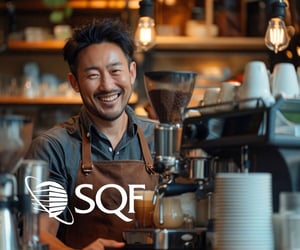Achieving SQF Certification: Ensuring Food Safety and Market Success
Safe Quality Food (SQF) certification is a globally recognized program that validates a company’s commitment to food safety and quality at every stage of the supply chain. While it may not be legally required, many retailers and food service providers expect their suppliers to be SQF certified, making it a key factor in market competitiveness.
In this article, we’ll explore what SQF certification entails, why it’s essential, and the steps involved in achieving certification. Whether you’re new to SQF or looking to improve your food safety systems, understanding the process can help you navigate certification successfully.
What Is SQF Certification?
SQF certification demonstrates that a company adheres to rigorous food safety and quality standards. It is recognized by the Global Food Safety Initiative (GFSI), which sets internationally accepted benchmarks for food safety management systems.
SQF certification applies to multiple sectors within the food industry, including:
-
Primary production (plant and animal)
- Food manufacturing
- Food packaging manufacturing
- Storage and distribution
- Food retail
-
Food service
Unlike other GFSI-recognized programs, SQF certification covers the entire supply chain, ensuring food safety from farm to fork.
Why Choose SQF Certification?
SQF certification provides businesses with several advantages beyond regulatory compliance. Some of the key benefits include:
Enhancing Food Safety & Consumer Protection
Food safety is the foundation of SQF certification. By implementing SQF standards, businesses can proactively reduce the risk of contamination, foodborne illnesses, and recalls.
Expanding Market Opportunities
Many retailers, food service providers, and manufacturers require SQF certification as a prerequisite for doing business. Certification can open doors to larger markets and new customers.
Strengthening Brand Reputation
Being SQF certified signals to stakeholders, partners, and consumers that your company prioritizes food safety and quality, increasing trust and credibility.
Improving Operational Efficiency
The certification process involves evaluating and refining internal processes, leading to better risk management, increased efficiency, and reduced waste. SQF may also reduce the need for multiple audits, saving time and resources.
The SQF Certification Process
SQF Certification Requirements
To achieve SQF certification, businesses must meet several key requirements based on the SQF Code. These include:
-
Development and implementation of a Hazard Analysis and Critical Control Points (HACCP) plan
- Documented food safety and quality management system
- Compliance with Good Manufacturing Practices (GMPs) and/or Good Agricultural Practices (GAPs)
- Employee training programs to ensure food safety knowledge
- Implementation of traceability and recall procedures
- Regular internal audits and corrective actions
-
Compliance with regulatory requirements applicable to the product and facility type
Each sector of the food supply chain has specific requirements outlined in the SQF Code, which businesses must adhere to based on their operations.
What is the cost for SQF Certification?
The cost of an SQF audit varies depending on several factors, including the size of the facility, the complexity of operations, and the audit duration. General cost considerations include:
- Audit Fees: Typically range from $5,000 to $15,000, depending on the size and complexity of the operation.
- Certification Body Fees: Additional costs may apply for certification issuance and maintenance.
- Pre-Assessment Audits: Optional audits to assess readiness before the official certification audit (typically $3,000 to $7,000).
- Annual Renewal Audits: SQF certification must be renewed annually, with similar cost structures applying for recertification audits.
Understanding these costs upfront allows businesses to plan their budget effectively for certification.
What are the requirements for SQF Certification?
Achieving SQF certification involves several key steps, ensuring a company has a robust food safety management system in place:
Step 1: Understanding the SQF Code
Businesses must familiarize themselves with the SQF Code, which outlines the requirements for certification based on their sector. The code is regularly updated to reflect industry best practices and regulatory expectations.
Step 2: Conducting a Gap Analysis
A gap analysis helps identify areas where current food safety practices do not meet SQF requirements. This assessment allows businesses to address deficiencies before undergoing an official audit.
Step 3: Implementing Food Safety and Quality Systems
Once gaps are identified, businesses must implement corrective actions. This includes developing and documenting food safety plans, employee training programs, and record-keeping systems to ensure ongoing compliance.
Step 4: Internal Audits and Pre-Assessment
Before scheduling an official certification audit, companies should conduct internal audits and, if necessary, a pre-assessment audit to identify any remaining areas that need improvement.
Step 5: SQF Certification Audit
A third-party SQF auditor will conduct an on-site evaluation to assess compliance with the SQF Code. The audit includes:
- Document Review – Evaluating food safety programs, HACCP plans, and record-keeping.
- Facility Inspection – Assessing adherence to food safety protocols and operational procedures.
- Employee Interviews – Ensuring staff understand and implement food safety policies correctly.
Step 6: Certification and Ongoing Compliance
If the audit is successful, the company receives SQF certification, which is valid for one year. To maintain certification, businesses must undergo annual audits and continuously improve their food safety systems.
Case Study: Coffee Roastery Achieves SQF Certification
Background: A mid-sized specialty coffee roasting company was looking to expand into wholesale and retail distribution. However, many potential customers required suppliers to have SQF certification. While the company had solid food safety practices in place, they lacked a formalized system to meet SQF standards.
Challenges:
- No formal Hazard Analysis and Critical Control Points (HACCP) plan
- Inconsistent documentation of food safety practices
- Limited internal audit experience
Solution: The company conducted a gap analysis and implemented a structured food safety plan. They developed HACCP-based risk assessments, improved documentation processes, and trained their team on food safety protocols. After a successful pre-assessment audit, they underwent the certification audit and passed.
Results:
- Successfully achieved SQF certification
- Gained access to new retail and food service markets
- Improved internal processes, reducing food safety risks and operational inefficiencies
Achieve SQF Certification with ASI
ASI has extensive experience guiding businesses through the SQF certification process. From training and gap analysis to pre-assessments and audit preparation, ASI helps streamline the path to certification. By partnering with ASI, you can ensure compliance, improve food safety systems, and enhance your company’s credibility in the marketplace.
Contact ASI today to take the next step toward SQF certification.
ASI: Your SQF Certification Body
At ASI, we make the SQF certification process seamless, efficient, and cost-effective. Our experienced team provides expert guidance, flexible scheduling, and transparent pricing to ensure you achieve certification without unnecessary delays or stress.

